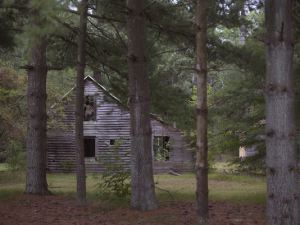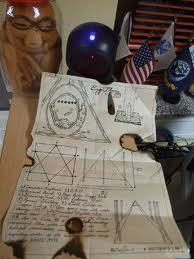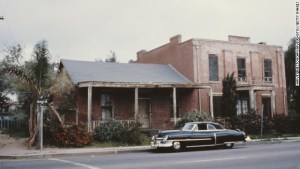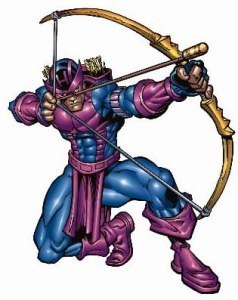Joseph Matheny's Blog, page 20
August 15, 2014
The Incunabula Papers: Ong’s Hat and Other Gateways to New Dimensions Audiobook
 A professional version of The Incunabula Papers: Ong’s Hat and Other Gateways to New Dimensions is currently in production for Audible.com. It should be available sometime in September. Here’s a sample of my conversation with Nick Herbert, so you can get a sense of the quality.
A professional version of The Incunabula Papers: Ong’s Hat and Other Gateways to New Dimensions is currently in production for Audible.com. It should be available sometime in September. Here’s a sample of my conversation with Nick Herbert, so you can get a sense of the quality. 
Filed under: Announcements, Incunabula, Ong's Hat








August 10, 2014
Life in the Pines: Ong���s Hat
Story from the Asbury Park Press, a New Jersey newspaper on the legend(s) of Ong’s Hat.
Some excerpts:
���Two weeks ago there were these young kids, like 19 or 20, who came by asking about Ong���s Hat,��� said bartender Jacky Colon. ���I looked it up on my phone. It was this weird interdimensional thing. Hold on, I have to look it up, this is how I got all my information on Google.���
Very short synopsis of said legend: Mash-up of religious sect, jazz musicians, native Pineys and rogue physicists settle in Ong���s Hat, open a portal to other dimensions. More on this later. First, that name.
——-
During a lull, you can ask about those legends. The modern one about Ong���s Hat ��� that portal to another dimension somewhere out in the pitch pines ��� was popularized in the 2002 book ���Ong���s Hat: The Beginning��� by writer Joseph Matheny, who creates transmedia works and is a prominent figure in alternative reality gaming.
���Nineteen eighty-nine, I think this started. I had a friend who had a cabin out there in the Pine Barrens, and he hosted these parties. He was very bohemian and had artists and writers of all kinds out there,��� Matheny said. ���He gave me a pamphlet that purported to be this story about Princeton scientists and something called the Ong���s Hat Rod and Gun Club, where they used to hang out and relax.���
During World War II the Pine Barrens were a testing ground for weapons development. Princeton scientists did explosives and ballistics work in the Forked Ruiver Mountains, and a Johns Hopkins University team fired crude surface-to-air missiles from the Project Bumblebee site at Island Beach. ���There are kernels of reality to this legend,��� Matheny said.
With Matheny and other contributors writing, the story line arose ithrough the 1990s, first on computer bulletin boards frequented by gaming enthusiasts, generating online versions of urban legend that���s grown to an elaborate body of work. One consequence is an uptick in younger visitors seeking Ong���s Hat. Hence Colon���s close encounter at the Magnolia Bar.
��Folklorists call it legend tripping ��� the urge to visit supposedly haunted houses and the like. One infamous place is Leed���s Point near Smithville in Atlantic County. The supposed birthplace of the Jersey Devil ��� a half-human monster said to haunt the forest since the 1700s ��� attracts people around Halloween.
But the Ong���s Hat story is one of the first examples of ���legend tripping online,��� said Michael Kinsella, a scholar who studies new religions, paranormal beliefs and folk traditions at the University of California Santa Barbara. He���s author of the 2011 book ���Legend-Tripping Online: Supernatural Folklore and the Search for Ong���s Hat,��� published by the University Press of Mississippi.
���I���ve always been fascinated by supernatural beliefs,��� said Kinsella, who like Ong���s Hat enthusiasts stumbled across the story online, and wrote a whole dissertation on it for his master���s degree in 2007, which led to the book. The cross-connections of various enthusiast websites ��� whether gaming, UFOs or conspiracy theories ��� lead like a trail of digital bread crumbs to Ong���s Hat.
He sees it as technology simply extending an ancient human compulsion. ���People really want to seek out the eerie and paranormal,��� Kinsela said.
There are other snippets from actual history in the Ong���s Hat portal legend, like radioactive waste. Around the time the legend was developing, the Department of Defense was figuring out what to do with thousands of tons of soil contaminated with plutonium when a nuclear missile burned up a few miles away at Fort Dix in 1961. That���s how modern legends grow, Kinsella said.
���It���s typical for these kinds of stories to mix up history and facts and legend,��� he said. ���So much weird stuff and stories seems to come out of the Pine Barrens, they reinforce each other.���
���If nothing else, it is a vortex of mysteries, legends, tradition and folklore…I���m interested in tracking it back as far as I can, but I don���t want to puncture that bubble,��� Matheny said. ���There���s nothing in the structure of the story that I haven���t heard, in one form or another, from people in the area.���
Filed under: Folklore, Incunabula, Interviews, Ong's Hat Tagged: featured, folklore, incunabula, Ong's Hat








Life in the Pines: Ong’s Hat
Story from the Asbury Park Press, a New Jersey newspaper on the legend(s) of Ong’s Hat.
Some excerpts:
“Two weeks ago there were these young kids, like 19 or 20, who came by asking about Ong’s Hat,” said bartender Jacky Colon. “I looked it up on my phone. It was this weird interdimensional thing. Hold on, I have to look it up, this is how I got all my information on Google.”
Very short synopsis of said legend: Mash-up of religious sect, jazz musicians, native Pineys and rogue physicists settle in Ong’s Hat, open a portal to other dimensions. More on this later. First, that name.
——-
During a lull, you can ask about those legends. The modern one about Ong’s Hat — that portal to another dimension somewhere out in the pitch pines — was popularized in the 2002 book “Ong’s Hat: The Beginning” by writer Joseph Matheny, who creates transmedia works and is a prominent figure in alternative reality gaming.
“Nineteen eighty-nine, I think this started. I had a friend who had a cabin out there in the Pine Barrens, and he hosted these parties. He was very bohemian and had artists and writers of all kinds out there,“ Matheny said. ‘He gave me a pamphlet that purported to be this story about Princeton scientists and something called the Ong’s Hat Rod and Gun Club, where they used to hang out and relax.“
During World War II the Pine Barrens were a testing ground for weapons development. Princeton scientists did explosives and ballistics work in the Forked Ruiver Mountains, and a Johns Hopkins University team fired crude surface-to-air missiles from the Project Bumblebee site at Island Beach. “There are kernels of reality to this legend,“ Matheny said.
With Matheny and other contributors writing, the story line arose ithrough the 1990s, first on computer bulletin boards frequented by gaming enthusiasts, generating online versions of urban legend that’s grown to an elaborate body of work. One consequence is an uptick in younger visitors seeking Ong’s Hat. Hence Colon’s close encounter at the Magnolia Bar.
Folklorists call it legend tripping — the urge to visit supposedly haunted houses and the like. One infamous place is Leed’s Point near Smithville in Atlantic County. The supposed birthplace of the Jersey Devil — a half-human monster said to haunt the forest since the 1700s — attracts people around Halloween.
But the Ong’s Hat story is one of the first examples of “legend tripping online,” said Michael Kinsella, a scholar who studies new religions, paranormal beliefs and folk traditions at the University of California Santa Barbara. He’s author of the 2011 book “Legend-Tripping Online: Supernatural Folklore and the Search for Ong’s Hat,” published by the University Press of Mississippi.
“I’ve always been fascinated by supernatural beliefs,” said Kinsella, who like Ong’s Hat enthusiasts stumbled across the story online, and wrote a whole dissertation on it for his master’s degree in 2007, which led to the book. The cross-connections of various enthusiast websites — whether gaming, UFOs or conspiracy theories — lead like a trail of digital bread crumbs to Ong’s Hat.
He sees it as technology simply extending an ancient human compulsion. “People really want to seek out the eerie and paranormal,” Kinsela said.
There are other snippets from actual history in the Ong’s Hat portal legend, like radioactive waste. Around the time the legend was developing, the Department of Defense was figuring out what to do with thousands of tons of soil contaminated with plutonium when a nuclear missile burned up a few miles away at Fort Dix in 1961. That’s how modern legends grow, Kinsella said.
“It’s typical for these kinds of stories to mix up history and facts and legend,” he said. “So much weird stuff and stories seems to come out of the Pine Barrens, they reinforce each other.”
“If nothing else, it is a vortex of mysteries, legends, tradition and folklore…I’m interested in tracking it back as far as I can, but I don’t want to puncture that bubble,“ Matheny said. “There’s nothing in the structure of the story that I haven’t heard, in one form or another, from people in the area.”
Filed under: Incunabula, Interviews, Ong's Hat








August 8, 2014
Will Transmedia eat itself for lunch? Or is it the end of Storytelling as we know it?
Transmedia as an idea of collaborative, multi-platform creation and narration origins in the 70’s and 80’s of the last century, in the area of telematic art, where artists experimented with collaborative narration and defined the idea of transmedia.
It soon moved on to the gaming industry, creating so-called Alternate Reality Games (ARG).These are games that, based on the Internet as a main hub, use(d) multiple other technological platforms like telephones, email and real offline mail to tell and simultaneously create different parts of the game’s story in those medial habitats relevant to the players. So not just transmedia telling, but transmedia engagement that requires interaction from every gamer in order to bring the game’s plot to the next level. In other words: “Players interact directly with characters in the game, solve plot-based challenges and puzzles, and collaborate as a community to analyze the story and coordinate real-life and online activities.” (Wikipedia) An early example being Ong’s Hat.
Filed under: Incunabula, Ong's Hat








August 7, 2014
2014 Literary References to Ong’s Hat in Other Works: A Collection
A few collected Ong’s Hat literary references from 2014. Other references pre-2014 can be found on the Reviews page. I only include the ones which directly relate to the legend as told in my works, not the historic references about the lost town itself.
Notice: Inclusion in this list in NO WAY IMPLIES AN ENDORSEMENT
Ong’s Hat spin off novels by other writers:
Conspiracy! The Movie, The Novel (Ong’s Hat Ashram legend plays a significant role in this book)
The Haunting of Ong’s Hat
Ong’s Hat by Steven Reeves (actually uses the Egg and the travel cults as a central theme in the story)
Ong’s Hat and a mysterious cult called The Ong’s Hat Flagellants plays a major role in Turnpike Flameout
Ong’s Hat and mysterious non-existent books describing dimensional portals (Ong’s Hat: Adventures of Other Dimensions and Time) used in the plot of Quhaunt’em: a novel
Other references (non-fiction)
My interview with Nick Herbert (from Ong’s Hat) referenced in The Physics of Miracles: Tapping in to the Field of Consciousness Potential
Ong’s Hat section in The Geomantic Year: A Calendar of Earth-Focused Festivals that Align the Plane t with the Galaxy
Ongs Hat mentioned in The Big Book of New Jersey Ghost Stories
Ong’s Hat mentioned in New Jersey Ghost Towns: Uncovering the Hidden Past
Ong’s Hat: The Beginning cited in Prisoner of Words
My friend D.R. Haney: Room 32 – A great story all on it’s own, but with the strange appearance of a picture from room 32 where the phrase “Jim is in Ong’s Hat” can clearly be seen. (also ran on Salon) The rest of “Room 32″ is now available as an e-book in the Kindle Store. To get it, please click here.
 Click to enlarge picture from DR Haney’s visit to Jim’s old room
Click to enlarge picture from DR Haney’s visit to Jim’s old room
News and Popular Media
A political post from Salon, , AUG 26, 2010 which has the quote: “The summer of 1963, then, was marked by graduation from the liturgical approach of loose, liberal Christianity to the crazy quilt Moorish Orthodox Church of America, my natural next home. An offshoot or perhaps incarnation of the Moorish Science Temple, the MOCA comprised a group of jazz musicians, poets, artists, improvisational comics and a few deeply weird people like the guy with the mustache and cape (that’s all I ever knew of his identity — he much resembled Brian Stack’s “The Interrupter” from the Conan O’Brien show decades later). As an acolyte of Salvador Dali (along with one of my close friends from school, who also taught martial arts and built explosive devices), the MOCA was a natural magnet for someone like me. It’s served me well off and on over the years as it has waxed and waned as a force. The nominal headquarters still operate in Ong’s Hat, N.J., in case anyone might conceivably be interested.”
Filed under: Appearances, books, Incunabula, Ong's Hat Tagged: incunabula, joseph matheny, Ong's Hat








Random References to Ong’s Hat- a Collection
A few collected Ong’s Hat literary references from 2014. Other references pre-2014 can be found on the Reviews page. I only include the ones which directly relate to the legend as told in my works, not the historic references about the lost town itself.
My interview with Nick Herbert (from Ong’s Hat) referenced in The Physics of Miracles: Tapping in to the Field of Consciousness Potential
Ong’s Hat section in The Geomantic Year: A Calendar of Earth-Focused Festivals that Align the Plane t with the Galaxy
Ongs Hat mentioned in The Big Book of New Jersey Ghost Stories
Ong’s Hat mentioned in New Jersey Ghost Towns: Uncovering the Hidden Past
Ong’s Hat and a mysterious cult called The Ong’s Hat Flagellants plays a major role in Turnpike Flameout
Ong’s Hat: The Beginning cited in Prisoner of Words
Ong’s Hat and mysterious non-existant books describing dimensional portals (Ong’s Hat: Adventures of Other Dimensions and Time) used in the plot of
More Random References: Collection
A few collected references:
Ong’s Hat: My interview with Nick Herbert referenced in The Physics of Miracles: Tapping in to the Field of Consciousness Potential
Ong’s Hat section in The Geomantic Year: A Calendar of Earth-Focused Festivals that Align the Planet with the Galaxy
Ongs Hat mentioned in The Big Book of New Jersey Ghost Stories
Ong’s Hat mentioned in New Jersey Ghost Towns: Uncovering the Hidden Past
My Diane DiPrima interview referenced in Breaking the Rule of Cool: Interviewing and Reading Women Beat Writers
Filed under: Appearances, books, Incunabula, Ong's Hat








July 30, 2014
CREEPYGAMING & THE NARRATIVE: A THEORY-BASED POP CULTURE OF ‘PLAYABLE’ LORE
Dominique Angela M. Juntado, M.A.
Doctoral Candidate in Social & Cultural Anthropology
University of the Philippines Diliman
Email: [email protected]
International Journal of Social Sciences
Abstract
Having been written for fellow fans of video game creepypastas and students of media anthropology and folklore, this article inspects said form of online lore as well as its complementing interactive media in terms of how experimentation with playable content
can effectively deliver not only an understanding of what transpired in a narrative, but more of a meaningful experience of a narrative. In theory, an interactive approach has much to contribute for the breadth of legend complexes.
Keywords: Creepypasta, ROM Hacks, Lost Episodes, Haunted Gaming, Democratized Production, Nontraditional Storytelling, Slender
To talk about a known, existing
contribution which encourages the inspection of
netlore and possible variants, Michael Kinsella‟s
[2011] work on internet-based folklore is worth
attention for having included guidelines on how
legends online could be assessed, the basics of
legend-tripping, as well as the importance of knowing how to go about ecologies of legends in
general. It is likewise memorable for its
ethnographic rumination on the Incunabula
papers and Ong‟s Hat which has previously
showcased the potential pertinence of alternate
reality games (ARGs) in both the reconstruction
as well as promotion of a legend. In his case
analysis, Kinsella [2011] spoke more of those
participating in the imersion within the legend —
their framing, emotions, and perceptions, as well
as their role in the legend‟s mortality.
On the one end, this discourse is in pursuit
of a personal inclination. But to place it in the
academic backdrop of the studies of media, it
complements the work of Russel Frank [2011]
and Michael Kinsella [2011] on the subject of
understanding how online lore works and
branches out through bringing the subject of
video game modification and hacking into the
academic theoretical limelight in terms of their
potential role in the deepening of netlore.
There is then a development into how
success of a video gaming creepypasta could be
assessed. The treatise then proceeds with an
analysis of how video game creepypastas with
playables could classify as a legend trip. This
segment is guided by Kinsella‟s [2011]
guidelines on understanding the structure of
legend trips, derived from the second chapter of
his book Legend-Tripping: Online Supernatural
Folklore and the Search for Ong’s Hat.
As a practical counterpart to the theoretical
ruminations, there is included a concise survey
of the existing forms of playable lore which
serve as the present genres. This is
complemented by a segment discussing classic
features to incorporate in the production of a
playable pasta as well as brief notes on avoiding
cliches.
http://www.tijoss.com/TIJOSS%2025th%20volume/8dominique.pdf
Filed under: Incunabula, Ong's Hat








July 25, 2014
Destinations Across Paranormal America 2
Chapter dedicated to Ong’s Hat in Destinations Across Paranormal America 2 by Hugh Mungus
Excerpt:
It’s a widely held belief the legend of Ong’s Hat is the fictional brainchild of author Joseph Matheny. Matheny posted his saga on the Internet in the early 1990s, in attempts to insert the story into the collective consciousness of the then-burgeoning World Wide Web. If you’ve ever watched the lonelygirl15 webisodes on http://www.youtube.com, you’ll understand this anecdotal blending with online reality. To those not familiar with lonelygirl15, it was the precursor to Destinations Across Paranormal America 20 vlogging, videotaping oneself rambling about various subject matter, and posting it on the Internet for the world to view. Debuting in 2006, lonelygirl15 was created by a group of young filmmakers. Although fictional, the show was initially believed by its audience to be fact. The story followed the everyday existence of a teenaged girl named Bree. As the production gained popularity, and its fanciful nature was revealed, two derivative series — centered around conspiracy theories — were produced.
Back to Ong’s Hat, baby! There are those who claim Matheny’s legend is true. Whether or not one believes the Ong’s Hat saga is beside the point, contends its creator, who asserts his work stemmed from an actual written narrative known as the Incunabula Papers. To be certain, it’s a lot of information to digest. Reading Ong’s Hat: The Beginning, listening to the Incunabula Papers on-line (see the Bibliography) or visiting southern New Jersey, would be great initial steps to unraveling this mystery.
Much more in the book! Read it all on-line (Ong’s Hat chapter begins on page 13)
Destinations Across Paranormal America 2 from hughmungus
or get it at Amazon
Filed under: Incunabula, Ong's Hat Tagged: incunabula, joseph matheny, Ong's Hat








April 29, 2014
Lists as Narrative Structure: Hawkeye #3 and Incunabula
Excellent observations on the Ong’s Hat/Incunabula mythos from Spittle Gauze
Lists seem to have a certain power over people. It is hard to find any form of media that does not utilize them often, since it is a way to convey a larger picture with a superficial set of objects. Since the efficacy of lists is so overwhelmingly apparent in modern media, it is a bit strange that they aren’t often used to create narratives, like hugely popular epistolary form. Recently, by happenstance, I’ve read 2 works of fiction (probably fiction!) that utilize lists to create their structure, Hawkeye #3 by Matt Fraction/David Aja and Incunabula by Joseph Matheny (probably!).
Although I read the Incunabula catalog first, it is a stickier topic, so I’ll start out withHawkeye. The 3rd issue of the new series by Fraction/Aja is a story created by the joining of two lists. The first is a series of bad decisions and the second a tally of different novelty arrows in the Avenger’s arsenal. The story starts out with Hawkeye in plain clothes attempting to label and clean up his assortment of trick arrows. To label them he needs some tape, so he travels out into the world where he commits a series of bad decisions. The narrative then unfolds as, out of order, Hawkeye makes a series of 9 poorly thought out actions. Punctuated between the action, which are given out of their list order, someone in the story uses each of his trick arrows (acid arrow, net arrow, boomerang arrow, etc). After setting up these two lists, the rest of the narrative unfolds almost solely by revealing the items of the list. The pace of the lists being revealed by word and image in the comic makes the story happen effortlessly and in a way that grabs the reader’s attention. Afterwards it is easy to see how painstakingly the structure was created to provide such a great read for the audience.
The other item on the list, Incunabula, is much harder to pin down. It is a catalog of print items available from a printed word distribution. The list of items available forms a narrative at least and, possibly, also a conspiracy theory. I happened upon this story as part of .zip file that supposedly contained a book of occult theory that discusses the Lovecraft Mythos as a nonfiction magickal construct. Inside the file was not only the book I wanted, but also Ong’s Hat: The Beginning by Joseph Matheny. I am not really sure why, but I ended up reading all of Incunabula and never even perusing the item I was after. The basis for the Ong’s Hat book is the Incunabula catalog that is reproduced in its pages.
While Hawkeye used lists inside a narrative to drive it, Incunabula was a rigid list that contained a story that appears after the whole catalog has been read. As the catalog progresses, certain points brought up in earlier entries are elucidated upon or given an erratic, confusing depth. The play on information as treasure is the reward for the reader trying to figure out what the story actually is. That is if it is a story at all and not a conspiracy theory or buried history. The gaps in the narrative require action from the reader outside of the text in the form of research. The end story in the audience’s mind ends up being as big or small as the amount of time and effort each viewer gives to the subject matter.
After encountering both of these stories in the span of a month or so, it seems strange that I haven’t encountered lists as narratives more often in my readings. After reading both pieces it is obvious that the bare bones list structure can create powerful narratives in a wealth of different applications. I also find it very strange that the two list based stories I read use the list in opposing methods, Hawkeye with the lists inside the story and Incunabula with the story inside the list. The synchronicity of the way these two items overlap is enough to make me believe in the conspiracy path theIncunabula attempts to lead its readers through. Maybe there are more examples of the list as a story and I’ve just never encountered them, but the complimentary aspects of these two works makes me start to cast myself in the role of the unreliable audience ( as opposed to the unreliable narrator structure). Hopefully I’ll notice a lot more of this method now that I am aware of it.
To read these stories yourself is pretty easy. The Hawkeye story can be purchased from comixology or at most comic book/regular book stores. Incunabula is available online at http://deoxy.org/inc1.htm or as part of Ong’s Hat: The Beginning from online retailers like amazon or its publisher Sky Books. If you know of any other stories similar, please drop me a line!
—[- Spittle Gauze
Link to original article
Also see Goodreads review by same author
Filed under: Incunabula, Ong's Hat



















